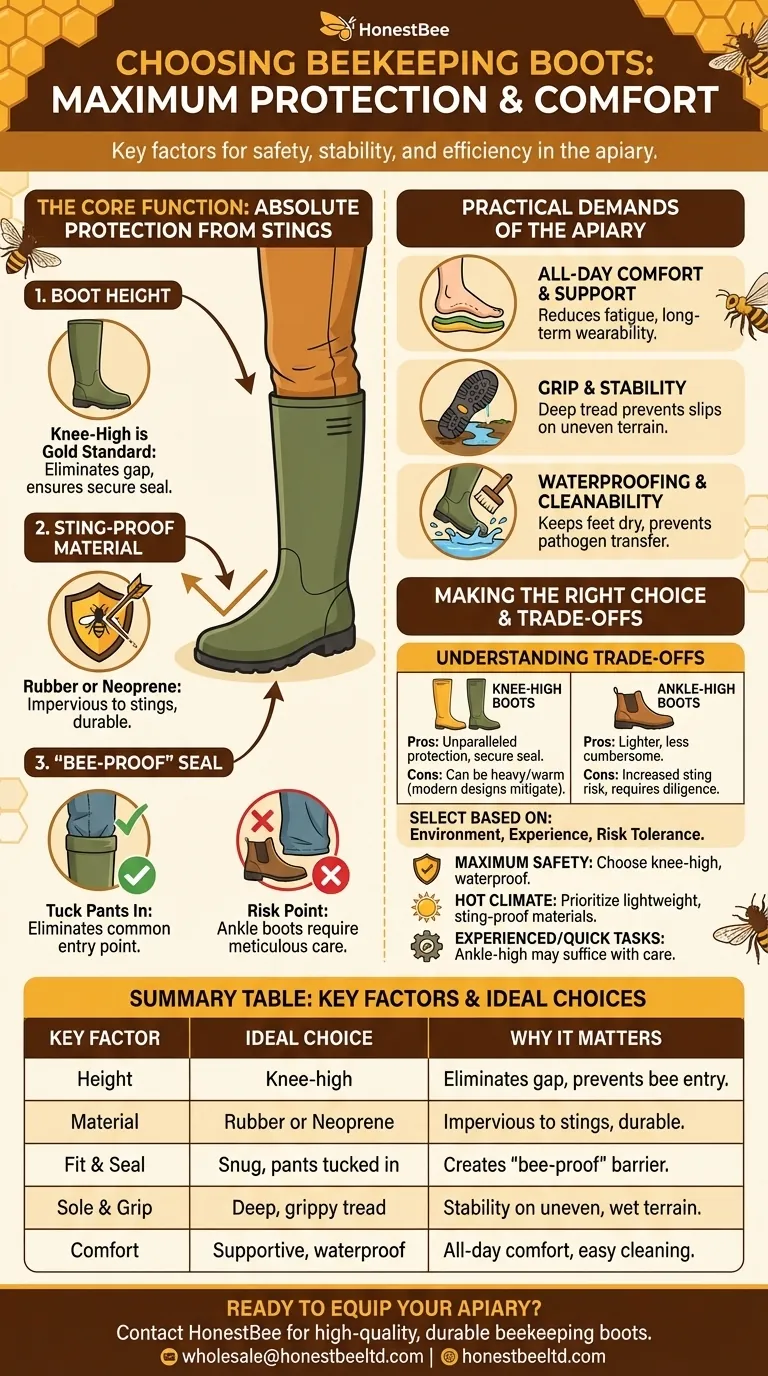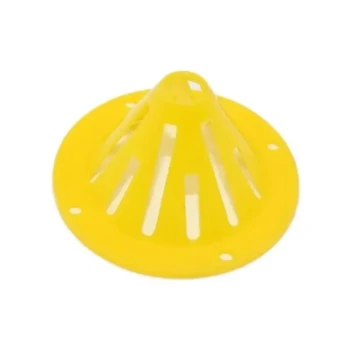When choosing beekeeping boots, the most critical factors are height for coverage, a sting-proof material like rubber or neoprene, and a snug fit that allows your pant legs to be tucked inside. These features work together to create an impenetrable barrier that protects your feet and lower legs from stings, ensuring you can work with confidence.
The search for beekeeping boots goes beyond simply avoiding stings. The right pair provides the safety, comfort, and stability needed to work effectively in an apiary for hours, transforming them from simple footwear into a fundamental piece of safety equipment.

The Core Function: Absolute Protection from Stings
Your primary goal is to prevent bees from accessing your skin. While feet and ankles are not the most common targets, a dropped frame or an agitated hive can change that in an instant.
Why Boot Height Matters
The most vulnerable point is the gap between your pants and your footwear. Bees are adept at finding and exploiting these openings.
Knee-high boots are the gold standard. They provide the most extensive coverage and make it simple to securely tuck in your bee suit or pants, creating a foolproof seal.
Ankle-high boots can be sufficient for very quick inspections, but they require meticulous care to ensure your pant legs stay tucked in and create a reliable seal. They represent a higher risk.
The Importance of Impenetrable Material
A bee's stinger can penetrate woven fabrics and thin materials. Your boots must be made of a substance that is genuinely sting-proof.
Rubber and neoprene, the materials used in muck boots or agricultural boots, are ideal. They are thick, durable, and completely impervious to stings.
Creating a "Bee-Proof" Seal
Owning the right boots is only half the battle. You must wear them correctly by tucking your pant legs or bee suit directly into the top of the boot. This simple action eliminates the single most common entry point for bees.
Beyond Protection: Practical Demands of the Apiary
Beekeeping involves more than just standing next to a hive. You will be walking on uneven ground, lifting heavy boxes, and dealing with the elements.
All-Day Comfort and Support
You will spend hours on your feet. Boots with poor support will lead to fatigue and discomfort, distracting you from your work. Look for boots designed for agricultural or outdoor work, as they prioritize long-term wearability.
Grip and Stability
Apiaries are often located on grass, dirt, or uneven terrain that can become slick when wet. A boot with a deep, grippy tread is a crucial safety feature that prevents slips and falls, especially when you're carrying a heavy super full of honey.
Waterproofing and Cleanability
Apiaries can be wet and muddy. Waterproof boots keep your feet dry and are significantly easier to clean. This is not just a matter of convenience; it helps prevent the transfer of dirt or potential pathogens from the ground into your hives.
Understanding the Trade-offs
No single boot is perfect for every person in every climate. Understanding the compromises is key to making an informed decision.
Knee-High Boots: Maximum Protection vs. Bulk
While they offer unparalleled protection, traditional knee-high rubber boots can be heavy and warm. In extremely hot climates, this can be a significant comfort issue. However, many modern designs use lighter-weight materials to mitigate this.
Ankle-High Boots: Convenience vs. Increased Risk
The primary benefit of an ankle boot is that it is lighter and less cumbersome. This convenience comes at the cost of protection. It should only be considered by experienced beekeepers for short tasks, with a full understanding of the risk involved.
Specialized vs. General-Purpose Boots
Some companies sell white "beekeeper boots." Functionally, these are often identical to standard agricultural muck boots but may come at a premium. A durable, comfortable muck boot from a farm supply store provides the exact same level of protection.
Making the Right Choice for Your Apiary
Select your boots based on your environment, experience level, and tolerance for risk.
- If your primary focus is maximum safety, especially as a beginner: Choose knee-high, waterproof boots made from rubber or neoprene to eliminate any weak points.
- If your primary focus is comfort in a hot climate: Prioritize lighter-weight, modern knee-high boots, but do not sacrifice sting-proof material or the ability to seal your pants inside.
- If you are an experienced beekeeper needing boots for quick, specific tasks: Ankle-high boots may suffice, but you must be diligent about sealing them and consciously accept the small but real risk.
The right boots are an investment in your safety and confidence, allowing you to focus completely on the health and productivity of your bees.
Summary Table:
| Key Factor | Ideal Choice | Why It Matters |
|---|---|---|
| Height | Knee-high boots | Eliminates the gap between pants and boots, preventing bee entry. |
| Material | Rubber or Neoprene | Impervious to bee stings and highly durable for long-term use. |
| Fit & Seal | Snug fit with pants tucked in | Creates a "bee-proof" barrier; essential for absolute protection. |
| Sole & Grip | Deep, grippy tread | Provides stability on uneven, wet terrain to prevent slips and falls. |
| Comfort | Supportive, waterproof design | Ensures all-day comfort and ease of cleaning after work in the apiary. |
Ready to equip your commercial apiary or distribution business with the best beekeeping boots?
At HONESTBEE, we supply high-quality, durable beekeeping supplies and equipment designed specifically for the rigorous demands of commercial beekeeping and wholesale distribution. Our sting-proof boots provide the absolute protection, comfort, and stability your team needs to work safely and efficiently, day in and day out.
Invest in safety and productivity. Contact our wholesale team today to discuss your equipment needs and volume pricing!
Visual Guide

Related Products
- Thick PVC Material Waterproof Anti-Slip Wear-Resistant Bee Work Shoes Boots for Garden Outdoor Utility
- Cotton Beekeeping Suit and Round Hat with Veil Bee Keeper Protective Gear
- Economy Polyester Beekeeping Jacket with Veil and Hat
- Beekeeping Jacket with Hood and Veil for Beekeepers
- White Beekeeping Protective Suit and Hat with Fencing Veil for Beekeepers
People Also Ask
- What is the importance of choosing the right beekeeping shoes? Ensure Safety and Comfort in the Apiary
- What are some examples of boots used for beekeeping? Essential Protection for Your Apiary Work
- Why is proper footwear important for beekeepers? Ensure Safety & Stability in the Apiary
- What is the importance of ensuring no gaps between pants and boots in beekeeping? Prevent Bee Intrusions & Stay Safe
- What safety precautions should be considered in beekeeping? Essential Protective Gear & Practices



















